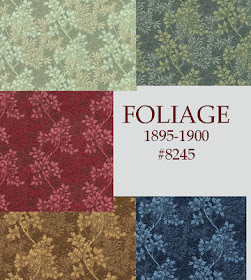Christmas Star
by Georgann Eglinski
Each of the seven prints in my new Morris Apprentice reproduction collection was designed by J.H. Dearle around the turn of the last century. Dearle was a versatile designer, creating pattern for glass, wovens and printed wallpapers. He did printed cottons but many of the designs had origins in other media. Below are details about three of the prints that you can find in a seasonal red. (We call it Red House Red after a William Morris home.)
"Tulips" in Red House Red
Georgann fussy cut the Tulips for her Christmas star mini. The stars are 6".
"Tulip" comes in five colorways. Dearle designed the print for woven wool yardage, dated by Linda Parry as 1895-1900. (See more about Parry's index at the bottom of this post.)
Those tulips are just the kind of flower Dearle loved for the gardens in his tapestries. The above detail is from one of the Holy Grail tapestries.
See a reproduction of a Dearle tapesty "Greenery" at the Metropolitan Museum of Art's website here:
Click on full-screen and then drag around and enlarge to see the detail.
Georgann fussy cut a vine from the "Foliage" print for her border.
"Foliage" also comes in five colorways. This pattern was designed by Dearle as wallpaper. The Victoria and Albert Museum has a sample from a wallpaper book which they date as 1899. See the paper here:
http://collections.vam.ac.uk/item/O251155/foliage-wallpaper-dearle-john-henry/
We've colored the Foliage print in monochromes and low-contrast shades so it makes a great background as well as a border. One of my sewing groups is finishing up a group project using the light green (8245-18 Sage Green) as a background in all the blocks.
We are auditioning (I think) the red Foliage for a final border here.
Georgann saved the triangles left over from the stars and made other mini.
With the "Artichoke" print for the border.
"Artichoke" is another Dearle design for wallpaper, registered in 1897. It really reflects his change from the Morris idea of medieval tapestry design in formal repeats to more organic Art-Nouveau-like flora with lots of curvy tendrils.
Artichoke is the largest and showiest piece in this collection and comes in six colorways.
We also used it as the border in the Morris Apprentice quilt for the Moda project sheet. It will be fun to see how quilters use this spectacular print.
See the free quilt pattern here at the Moda website:
Here's a free quilt label for a Morris mini or full-size project. You can print it onto prepared fabric with your desktop printer by clicking on the picture. Or click here to see a PDF.
I modified a design from the Morris Company's catalog in the early twentieth century. The frame is one of the woodblock printed borders they were famous for.
Linda Parry's book William Morris Textiles is the standard index for textiles from Morris and Co.
It was published in 1985 by Viking Penguin.
It's available as a used book rather inexpensively.
























































